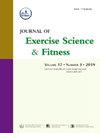缺血预处理和等长运动对高血压前期男性血压的急性影响
IF 2.4
2区 医学
Q2 SPORT SCIENCES
引用次数: 0
摘要
目的研究与2分钟缺血(IR2)或2分钟等距启动(IM2)相比,5分钟缺血预处理(IR5)是否能更有效地降低亚极限运动血压和改善肌肉氧合。方法20例未经训练的男性(高血压前期10例,血压正常10例)按随机顺序完成IR5 (3 × 5分钟双侧肢体阻断220 mmHg)、IR2 (3 × 2分钟双侧肢体阻断)和IM2 (3 × 2分钟30%最大自主收缩等距膝关节伸展),然后进行次最大运动试验。结果是运动心率(HR)、收缩压(SBP)、舒张压(DBP)、平均动脉压(MAP)和股外侧肌氧合,包括Δdeoxyhemoglobin (ΔHHb)、Δtotal血红蛋白(ΔtHb)和Δtissue饱和指数(ΔTSI)。结果与IR2和IM2相比,sir5显著降低了亚极大血压反应,降低收缩压的平均差(MD) = - 2.23 mmHg (P < 0.001, ηp2 = 0.395)。显著的条件与组间相互作用(P = 0.023)表明MAP降低仅限于高血压前期参与者(MD = - 3.14 mmHg, P = 0.003)。运动时IR5增加ΔtHb的幅度为MD = 1.56 μmol/L (ηp2 = 0.606),在不改变ΔHHb的情况下,IR5减轻ΔTSI的幅度为MD = 2.98% (ηp2 = 0.716)。相比之下,IR2和IM2引起类似的闭塞期脱氧,但没有改变运动血流动力学或氧合指标。结论ir5能有效降低次大运动时收缩压和MAP,改善肌肉氧合。这是一种安全的、非药物的运动前策略,可以控制血压并潜在地降低心血管风险。本文章由计算机程序翻译,如有差异,请以英文原文为准。
Acute effects of ischemic preconditioning and isometric exercise on blood pressure in prehypertensive males
Objective
This study investigates whether 5-min ischemic preconditioning (IR5) more effectively reduces submaximal exercise blood pressure and improves muscle oxygenation compared to 2-min ischemia (IR2) or 2-min isometric priming (IM2).
Methods
Twenty untrained men (10 prehypertensive; 10 normotensive) completed, in randomized order, IR5 (3 × 5 min bilateral limb occlusion at 220 mmHg), IR2 (3 × 2 min bilateral occlusion), and IM2 (3 × 2 min 30 % maximal voluntary contraction isometric knee extension), each followed by the submaximal exercise test. Outcomes were exercise heart rate (HR), systolic blood pressure (SBP), diastolic blood pressure (DBP), mean arterial pressure (MAP), and vastus lateralis muscle oxygenation including Δdeoxyhemoglobin (ΔHHb), Δtotal hemoglobin (ΔtHb), and Δtissue saturation index (ΔTSI).
Results
IR5 significantly attenuated the submaximal pressor response, reducing SBP by mean difference (MD) = −2.23 mmHg (P < .001, ηp2 = 0.395) compared with both IR2 and IM2. A significant Condition × Group interaction (P = .023) indicated that the MAP reduction was confined to prehypertensive participants (MD = −3.14 mmHg, P = .003). During exercise, IR5 increased ΔtHb by MD = 1.56 μmol/L (ηp2 = 0.606) and mitigated the decline in ΔTSI by MD = 2.98 % (ηp2 = 0.716) without altering ΔHHb. In contrast, IR2 and IM2 elicited similar occlusion-phase deoxygenation but did not modify exercise hemodynamics or oxygenation metrics.
Conclusion
IR5 effectively lowers SBP and MAP during submaximal exercise and improves muscle oxygenation. It is a safe, non-pharmacological pre-exercise strategy to manage blood pressure and potentially reduce cardiovascular risk.
求助全文
通过发布文献求助,成功后即可免费获取论文全文。
去求助
来源期刊
CiteScore
5.10
自引率
3.60%
发文量
54
审稿时长
31 days
期刊介绍:
The Journal of Exercise Science and Fitness is the official peer-reviewed journal of The Society of Chinese Scholars on Exercise Physiology and Fitness (SCSEPF), the Physical Fitness Association of Hong Kong, China (HKPFA), and the Hong Kong Association of Sports Medicine and Sports Science (HKASMSS). It is published twice a year, in June and December, by Elsevier.
The Journal accepts original investigations, comprehensive reviews, case studies and short communications on current topics in exercise science, physical fitness and physical education.

 求助内容:
求助内容: 应助结果提醒方式:
应助结果提醒方式:


